Division of Bennelong
The Division of Bennelong is an Australian electoral division in the state of New South Wales. The division was created in 1949 and is named after Woollarawarre Bennelong, an Aboriginal man befriended by the first Governor of New South Wales, Arthur Phillip.
| Bennelong Australian House of Representatives Division | |
|---|---|
 Division of Bennelong shown within Sydney, as of the 2016 federal election. | |
| Created | 1949 |
| MP | John Alexander |
| Party | Liberal |
| Namesake | Woollarawarre Bennelong |
| Electors | 108,872 (2019) |
| Area | 60 km2 (23.2 sq mi) |
| Demographic | Inner Metropolitan |
Bennelong covers 60 km2 of the Northern Sydney region, including all of the local government areas of Ryde and parts of Hornsby and Parramatta. It includes the suburbs of Denistone, Denistone East, Denistone West, East Ryde, Eastwood, Epping, Macquarie Park, Marsfield, Meadowbank, Melrose Park, North Epping, North Ryde, Putney, Ryde, Tennyson Point and West Ryde; as well as parts of Beecroft, Carlingford, Chatswood West, Dundas, Ermington and Gladesville.
It was represented from 1974 until 2007 by John Howard, who served as the Prime Minister of Australia from 1996 until 2007. As well as his government then being defeated, Howard also became the second sitting Australian Prime Minister to lose his own seat. Though historically a fairly safe Liberal seat, modern-day electoral boundaries and demographic changes have seen Bennelong become an increasingly marginal seat. The 2007 outcome in Bennelong resulted in Labor candidate Maxine McKew winning the seat on a thin 1.4 percent margin after a close contest, making her the first Labor MP for Bennelong. After a single term, McKew was defeated by Liberal candidate John Alexander in 2010, who has retained it since (despite a short vacancy in 2017).
The seat was vacant from 11 November 2017 when Alexander resigned amid the 2017–18 Australian parliamentary eligibility crisis after confirming he was a dual citizen and therefore ineligible to sit in parliament. Despite a significant swing against him, Alexander was re-elected at the 2017 Bennelong by-election on 16 December.
Electoral history
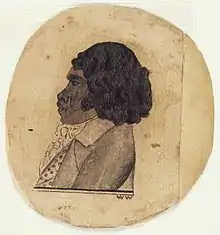
When the Division of Bennelong was created in 1949, it covered mainly the suburbs of Ryde, Hunters Hill and Lane Cove, all of which were (and still are) relatively affluent areas, and as such it has historically been a "fairly safe" Liberal seat.
Over the years Bennelong became increasingly marginal, and this has been attributed to two factors. Firstly, the electoral boundary of Bennelong has been redrawn ("redistributed") numerous times, pushing it further westward into Labor-friendly territory. Successive redistributions eliminated Lane Cove and Hunters Hill in the east and incorporated Eastwood, Epping, Carlingford and middle-class Ermington in the north and west. Secondly, the demographic has changed as well: since the early 1990s, Eastwood and surrounding suburbs have seen an influx of migrants from China, Hong Kong, South Korea and India, who are relatively affluent and conservative, but are sensitive towards political policies on immigration and multiculturalism.[1]
1998 election
In 1998, Prime Minister John Howard finished just short of a majority on the first count in the seat, and was only assured of re-election on the ninth count. He ultimately won a fairly comfortable 56 percent of the two-party-preferred vote.
2004 election
In 2004, for the second time since becoming Prime Minister, Howard came up short of a majority in the first count for the seat. He was assured of re-election on the third count, ultimately winning 53.3 percent of the two-party-preferred vote. The two-party-preferred vote for the Liberals declined 3.4% in the 2004 election, contrary to a strong national trend to the Coalition (and a particularly strong one to the Coalition in outer-suburban metropolitan seats), making Bennelong a marginal seat at that time, with a margin of just 4.3%. The 2006 redistribution pushed this margin slightly further into Labor territory, due to the inclusion of the predominantly working-class and public housing suburb of Ermington in Bennelong's boundaries.[2] The Greens increased their vote at this election by 12.34% to 16.37% at this election, owing to the pre-selection of the high-profile Andrew Wilkie as candidate.
2007 election
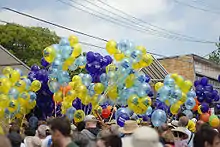
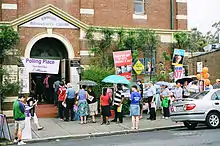
In the 2007 election, the incumbent Member for Bennelong, then-Prime Minister John Howard, lost the seat to Labor candidate Maxine McKew, after holding it for 33 years. This was only the second time in Australian history that an incumbent Prime Minister had been defeated in his own electorate, the first being Stanley Bruce in 1929. The election marked the first time a Labor candidate won, and also the first time a woman won the seat.
In his national address conceding the election, Howard admitted that it was "very likely" that he had lost the seat, and many media outlets listed Bennelong as a Labor gain on election night.[3] Following initial reluctance to officially call the outcome (despite confidence of success),[4][5] McKew declared victory officially on 1 December.[6][7] At that time, the Australian Electoral Commission showed McKew ahead on a two-candidate-preferred basis, by 43,272 votes to 41,159;[8] however, pre-poll, postal and absent votes were still being counted and could possibly have affected the outcome.
Howard formally conceded defeat in Bennelong on 12 December.[9] The Electoral Commission declared the seat, with 44,685 votes for McKew to 42,251 for Howard. McKew led for most of the night, and ultimately won on the 14th count after over three-fourths of Green preferences flowed to her. Voter turnout in Bennelong was 95%.[10]
Polls
| Date | Poller | Coalition | Labor |
|---|---|---|---|
| 3 October 1998 | 1998 election[11] | 56.03% | 43.97% |
| 4–5 April 2001 | Roy Morgan[12] | 57% | 43% |
| 10 November 2001 | 2001 election[13] | 57.70% | 42.30% |
| 9 October 2004 | 2004 election[14] | 54.33% | 45.67% |
| 14–15 February 2007 | Roy Morgan[15] | 45% | 55% |
| 9–10 May 2007 | Galaxy | 48% | 52% |
| 8–9 August 2007 | Galaxy | 47% | 53% |
2010–17
For the 2010 federal election, the Liberal Party pre-selected former tennis professional and tennis commentator John Alexander to contest the marginal seat. McKew recontested the seat for Labor.[16] After a long and high-profile campaign, Alexander won the seat back from Labor; he increased both the Liberals' two-party-preferred and primary vote for the first time since 2001, and gained the largest swing towards the Liberals since 1996. Alexander defeated McKew with a two-party-preferred swing of 4.52% (cf. the 2.58% national swing in the 2010 federal election), contributing to the Gillard Government's loss of its parliamentary majority.[17]
McKew said Labor had failed to repeat the professional and targeted campaign of 2007. She also conceded that the removal of Kevin Rudd as Prime Minister had been a factor in the party's poor showing, along with the Government's dumping of the emissions trading scheme and a lacklustre national campaign.[18]
Alexander picked up a four-percent swing in the 2013 federal election as the Coalition returned to government, returning Bennelong to its traditional status as a safe Liberal seat. He was reelected in 2016 with a small swing in his favour, even as the Coalition barely won a second term. On 11 November 2017, Alexander resigned his seat over questions of his eligibility to stand under section 44 of the Constitution,[19] necessitating a by-election.
2017 by-election
Amid the 2017–18 Australian parliamentary eligibility crisis, the trigger for the by-election was the resignation of Liberal incumbent John Alexander effective 11 November 2017. A few weeks following the increased clarity which came from the judgment of the High Court of Australia sitting as the Court of Disputed Returns on 27 October 2017 further determining dual citizenship ineligibility under Section 44 of the Constitution, Alexander resigned due to a belief that he may have held British citizenship at the time of his nomination and election, meaning he would be ineligible under Section 44 of the Constitution to sit in the Parliament of Australia. Alexander renounced any British citizenship he may have held, or otherwise been eligible for, in order to nominate for election again.[20]
Alexander won the 2017 Bennelong by-election despite an approximate five percent two-party swing away to Labor candidate Kristina Keneally which made the seat marginal.[21]
Members
| Image | Member | Party | Term | Notes | |
|---|---|---|---|---|---|
 |
(Sir) John Cramer (1896–1994) |
Liberal | 10 December 1949 – 11 April 1974 |
Served as minister under Menzies. Retired. Last person born before Federation to serve in the House of Representatives | |
 |
John Howard (1939–) |
Liberal | 18 May 1974 – 24 November 2007 |
Served as minister under Fraser. Served as Opposition Leader from 1985 to 1989, and from 1995 to 1996. Served as Prime Minister from 1996 to 2007. Lost seat | |
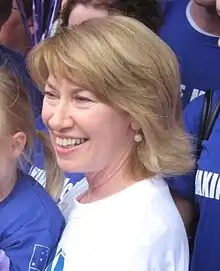 |
Maxine McKew (1953–) |
Labor | 24 November 2007 – 21 August 2010 |
Lost seat | |
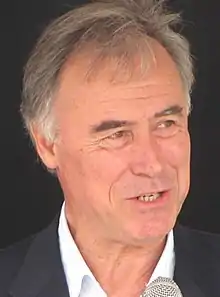 |
John Alexander (1951–) |
Liberal | 21 August 2010 – present |
Incumbent |
Election results
| Party | Candidate | Votes | % | ±% | |
|---|---|---|---|---|---|
| Liberal | John Alexander | 48,942 | 50.82 | +0.41 | |
| Labor | Brian Owler | 32,769 | 34.03 | +5.55 | |
| Greens | Qiu Yue Zhang | 9,116 | 9.47 | +0.34 | |
| Christian Democrats | Julie Worsley | 3,588 | 3.73 | −2.67 | |
| United Australia | Andrew Marks | 1,890 | 1.96 | +1.96 | |
| Total formal votes | 96,305 | 94.84 | −0.07 | ||
| Informal votes | 5,237 | 5.16 | +0.07 | ||
| Turnout | 101,542 | 93.32 | +1.61 | ||
| Two-party-preferred result | |||||
| Liberal | John Alexander | 54,809 | 56.91 | −2.81 | |
| Labor | Brian Owler | 41,496 | 43.09 | +2.81 | |
| Liberal hold | Swing | −2.81 | |||
Demographics
Demographic information is recorded in the Australian Bureau of Statistics 2011 census profile.[23]
References
- Saville, Margot (2007). The Battle for Bennelong: The adventures of Maxine McKew, aged 50something. Melbourne University Press.
- "Archive for the 'Federal Redistributions' Category". The Poll Bludger. 13 September 2006. Retrieved 25 November 2007.
- "Defeated Howard thanks Australia". ABC News. Australia. 25 November 2007. Retrieved 25 November 2007.
- "McKew refuses to call Bennelong". News.com.au. 25 November 2007. Retrieved 1 December 2007.
- "McKew confident but can wait to declare". The Australian. 26 November 2007. Retrieved 1 December 2007.
- "McKew declares victory in Bennelong". ABC News. Australia. 1 December 2007. Retrieved 1 December 2007.
- "Maxine McKew claims victory in Bennelong". The Sydney Morning Herald. 1 December 2007. Retrieved 1 December 2007.
- "House of Representatives Division First Preferences". Australian Electoral Commission. 30 November 2007. Retrieved 1 December 2007.
- "Finally, Howard admits McKew has it". The Sydney Morning Herald. 12 December 2007. Retrieved 13 December 2007.
- "House of Representatives Division First Preferences". Australian Electoral Commission. 11 December 2007. Retrieved 13 December 2007.
- "House of Representatives – Two Party Preferred Statistics by Division (1998)". Australian Electoral Commission. 9 August 2007. Retrieved 25 November 2007.
- ""Safe" Liberal Seats Not So Safe According To Latest Bulletin-Morgan Poll". Roy Morgan Research. 17 April 2001. Archived from the original on 17 December 2007. Retrieved 25 November 2007.
- "House of Representatives: Divisional Results". Australian Electoral Commission. Retrieved 25 November 2007.
- "Bennelong – Divisional Profiles". Australian Electoral Commission. 15 October 2007. Retrieved 25 November 2007.
- "Special Crikey Morgan Poll: Howard Would Lose Bennelong". Roy Morgan Research. 19 February 2007. Archived from the original on 7 September 2007. Retrieved 25 November 2007.
- "Four Liberals vying for Bennelong seat". ABC News. 20 November 2009. Retrieved 28 February 2010.
- "Bennelong, NSW". Election 2010. Australian Electoral Commission. 2010.
- "Labor bloodbath begins and Maxine McKew throws the first punch". news.com.au. 22 August 2010.
- "Alexander resigns from parliament, says he's 'most likely' a dual citizen". ABC News. 11 November 2017. Retrieved 11 November 2017.
- Robertson, James (17 November 2017). "John Alexander confirms eligibility to stand in byelection on advice from UK Home Office". The Sydney Morning Herald. Retrieved 18 November 2017.
- Bennelong by-election: Liberal John Alexander wins, Labor buoyed by swing: ABC 16 December 2017
- Bennelong, NSW, Tally Room 2019, Australian Electoral Commission.
- "2011 Census Community Profiles. Bennelong, NSW". Australian Bureau of Statistics. Retrieved 21 December 2017.